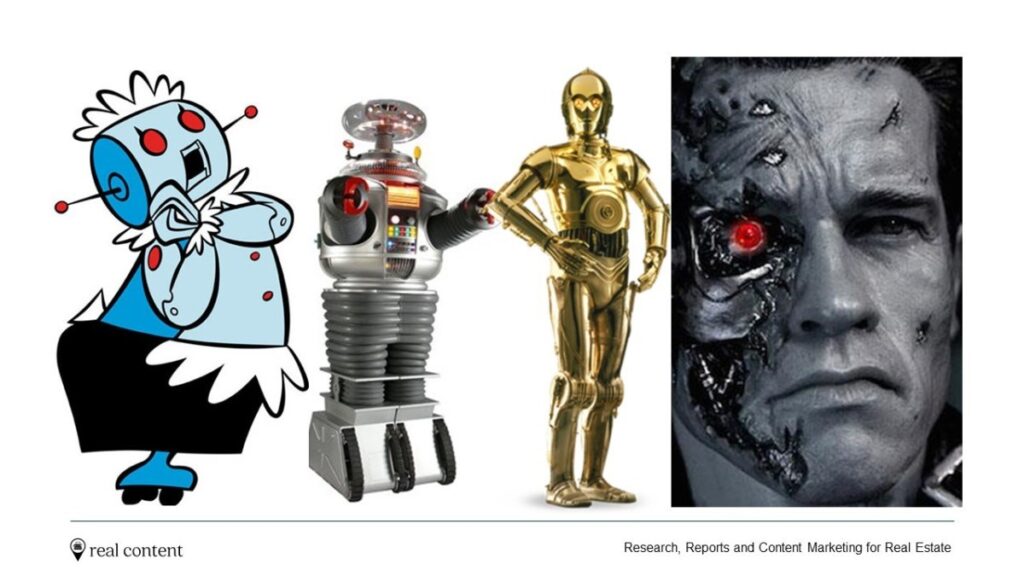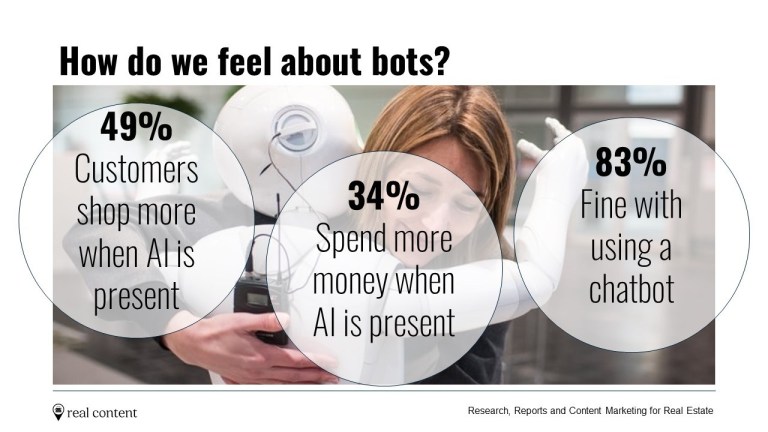Robots are already a ‘thing’ in real estate agencies whether you believe it or not. They are automating content creation, sending email, interrogating databases, responding to client inquiries and even telling your sales team who to call and what to say.

We tend to dismiss the notion because we expect a robot to look like C3PO, Rosie from the Jetsons, or even the Warning Will Robinson, Danger robot from Lost in space. But the bots of today are more likely to behave like the computer in Star Trek – an omnipresent being that can be called on at any time to make calculations, solve problems and alert you to issues while also determining the best course of action. Your Google Home won’t make your morning coffee (yet!) but she will try to make sure you leave the house in time to get to work based on current traffic conditions.
To make a robot, take several parts automation, add artificial intelligence and connect it to data. This leads to the question of what’s the difference between automation and AI? Automation is programming to repeat tasks, or manage repetitive tasks in the same way, always. AI “learns” from it surrounds recognising different actions to take under different circumstances, and calculating probability to identify the best options, measuring the response and adjusting its course as a result of the outcome.

This is both amazing, and a bit weird in equal measures. But when you get your brain around it, it becomes liberating and the help it offers us as human, immense. Research from retail analytics company Pointsource shows 49% of customers shop more when AI is present in a retail environment while 34% of us will spend more money. Additionally, 83% of us are fine using a chatbot. Why? We’d rather have some help at the time we need it from an artificial source, than no help and a game of telephone tango two days after you’ve forgotten why you wanted assistance in the first place. And that’s where robots in real estate come in.

Research from Macquarie Bank shows 25% of processes within a real estate agency could be automated right now using existing technology. Other studies put this figure – especially in property management departments – even higher.
Add this to US figures that show that 41% of real estate agent inquiries never get answered and 50% take three days or more to generate a response, and the case for some robotic assistance in real estate is easily made.
In Australia, there’s three kinds of ‘bots’ that I’m seeing starting to gain traction in smarter-run offices.
- Chatbots
Chatbots are being used on websites to respond to inquiries immediately. Chatbots are able to answer basic questions, capture intent and contact details but most importantly, they feel a lot more personal than filling in a form and waiting for a response. Research shows that the chances of qualifying a lead drops by 400% if it is left for longer than five minutes. Chatbots solve this issue quickly and easily for both agents and consumers.
- Marketing automation
Every agent has a database but only a small proportion of agents actually nurture their contacts or stay in contact in meaningful ways. Enter real estate specific marketing automations like ActivePipe, Adfenix and even HomePrezzo. ActivePipe uses a mix of automation and AI to make creating and targeting email campaigns easy, together with the added benefit of intention analysis and lead scoring based on the interaction your audience has with that content. Adfenix helps agent generate more website traffic through targeted Facebook campaigns, while HomePrezzo helps agents create and share market data content in a tenth of the time it takes to research and write it manually.

- Process and back office automation
Increasingly, real estate CRMS and property management tools are including automations to smooth over pain points in agents’ days. Check out VaultRE, Property Tree and Inspect RE as just a few examples.
But the bot that brings all of this together in a real estate office is Rita from AIRE. Rita is a ‘digital employee’ who can be programmed to do back office tasks such as data entry, data matching, and data analysis, which she does with a consistency and relish that is quite disconcerting. Offices using her well are using her to respond to and capture incoming inquiries from real estate portals, emails and online forms, matching those inquiries against the agency’s database to identify if the person is known to them, comparing them to larger property databases to identify the last time they transacted and then ranking leads and messaging agents to tell them who to call in what order and why.
So how do you adopt robot-based technology into your business?
Surprisingly, the answer is not technical, it’s an issue of quality management and leadership. Robots are not silver bullets that solve every problem in a broken business. They are only as good as the people and processes that they’re being introduced to. If your processes are poor, your bot experience will be just as underwhelming.
Instead, robots – by taking away a lot of the busy, repetitive and complicated work that is deeply time consuming - amplify the humanness of our businesses because they give us the time back to think creatively and nurture relationships. So to this end, here are some rules for how to introduce more automation into your business:
What does amazing look like?
Stop thinking about the current problems you want solved in your business, and start thinking bigger about how to create a truly amazing experience for the sellers, buyers, landlords and tenants that you serve – as well as your staff.
Identify the pain points first, not the technology
The next step is to identify the issues that are preventing you from delivering this wonderful golden experience. If you have a clear idea of the vision of service you want to offer and the things that are preventing it from happening, it’s easier to assess technical solutions that will achieve what you want.
Map the distance between here and Amazing
How far away is your agency currently from that amazing experience? Don’t despair. They say a journey starts with a single step. Identify the likely path you’re going to need to go on, and the steps that will help you get there.
Identify projects where Automation, AI and humans can meet
AI and automation won’t do everything all at once. You need humans to articulate the process and teach the bots how you want things done. Identify some projects you can undertake and rank them according to difficulty, the time it will take to complete, the benefits they offer and the willingness of your team to participate.
Experiment, test, learn and repeat
From your project list, identify the easiest one to kick off with. Expect there to be some hiccups. Expect it to take a bit longer than you wanted, and be a bit harder than you hoped. But stick with it. It’s only a failure if you don’t learn anything from it, give up and walk away. Consider your projects as experiments and tweak and learn. It will get easier with each one and before you know it, your office will be dramatically automated.
Humans plus robots make the most wonderful teams!
Know of any robots working in Australian or NZ real estate? I'd love to hear about them. Drop me an email!
